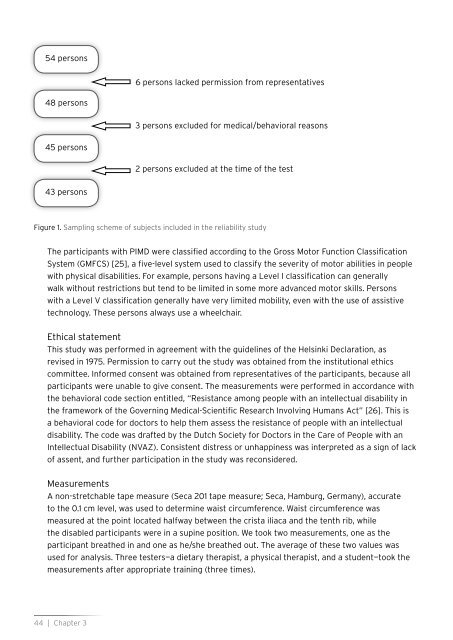Measuring physical fitness in Persons with Severe/Profound ...
Measuring physical fitness in Persons with Severe/Profound ...
Measuring physical fitness in Persons with Severe/Profound ...
- No tags were found...
Create successful ePaper yourself
Turn your PDF publications into a flip-book with our unique Google optimized e-Paper software.
54 persons6 persons lacked permission from representatives48 persons3 persons excluded for medical/behavioral reasons45 persons2 persons excluded at the time of the test43 personsFigure 1. Sampl<strong>in</strong>g scheme of subjects <strong>in</strong>cluded <strong>in</strong> the reliability studyThe participants <strong>with</strong> PIMD were classified accord<strong>in</strong>g to the Gross Motor Function ClassificationSystem (GMFCS) [25], a five-level system used to classify the severity of motor abilities <strong>in</strong> people<strong>with</strong> <strong>physical</strong> disabilities. For example, persons hav<strong>in</strong>g a Level I classification can generallywalk <strong>with</strong>out restrictions but tend to be limited <strong>in</strong> some more advanced motor skills. <strong>Persons</strong><strong>with</strong> a Level V classification generally have very limited mobility, even <strong>with</strong> the use of assistivetechnology. These persons always use a wheelchair.Ethical statementThis study was performed <strong>in</strong> agreement <strong>with</strong> the guidel<strong>in</strong>es of the Hels<strong>in</strong>ki Declaration, asrevised <strong>in</strong> 1975. Permission to carry out the study was obta<strong>in</strong>ed from the <strong>in</strong>stitutional ethicscommittee. Informed consent was obta<strong>in</strong>ed from representatives of the participants, because allparticipants were unable to give consent. The measurements were performed <strong>in</strong> accordance <strong>with</strong>the behavioral code section entitled, “Resistance among people <strong>with</strong> an <strong>in</strong>tellectual disability <strong>in</strong>the framework of the Govern<strong>in</strong>g Medical-Scientific Research Involv<strong>in</strong>g Humans Act” [26]. This isa behavioral code for doctors to help them assess the resistance of people <strong>with</strong> an <strong>in</strong>tellectualdisability. The code was drafted by the Dutch Society for Doctors <strong>in</strong> the Care of People <strong>with</strong> anIntellectual Disability (NVAZ). Consistent distress or unhapp<strong>in</strong>ess was <strong>in</strong>terpreted as a sign of lackof assent, and further participation <strong>in</strong> the study was reconsidered.MeasurementsA non-stretchable tape measure (Seca 201 tape measure; Seca, Hamburg, Germany), accurateto the 0.1 cm level, was used to determ<strong>in</strong>e waist circumference. Waist circumference wasmeasured at the po<strong>in</strong>t located halfway between the crista iliaca and the tenth rib, whilethe disabled participants were <strong>in</strong> a sup<strong>in</strong>e position. We took two measurements, one as theparticipant breathed <strong>in</strong> and one as he/she breathed out. The average of these two values wasused for analysis. Three testers—a dietary therapist, a <strong>physical</strong> therapist, and a student—took themeasurements after appropriate tra<strong>in</strong><strong>in</strong>g (three times).44 | Chapter 3











